Development of Nonlinear Six-Degree-of-Freedom Dynamic Modelling and High-Fidelity Flight Simulation of an Autonomous Airship
Abstract
1. Introduction
1.1. Airship Model Estimation
1.2. Airship Model Identification
1.3. Nonlinear Control-Oriented Modelling
1.4. High-Fidelity Modelling for Simulation
2. Airship Modelling
| Dynamic force vector. It contains Coriolis forces and centrifugal forces. | |||
| Aerodynamic force vector. It comprises forces acting on the airship hull due to air, when it cruises through it. | |||
| Aerostatic force vector. It contains forces due to buoyancy and airship weight. | |||
| Propulsion force vector. It contains forces acting on the airship due to thrusters. | |||
| Aerodynamic forces acting on the airship due to control surface deflection. | |||
| = | Wind gust acting on the airship. | ||
| Mass matrix. It contains airship mass, added mass, inertia, and added inertia terms. | |||
| Vector containing linear and angular acceleration terms in the airship body reference frame. |
2.1. Dynamic Forces
| : | Airship volume | |
| : | Mass of airship | |
| : | Gravitational acceleration | |
| : | Airship heaviness value (it is zero for the neutral buoyancy case) | |
| : | Moment of inertia about x-axis | |
| : | Moment of inertia about y-axis | |
| : | Moment of inertia about z-axis | |
| : | Moment of inertia about xz-axis | |
| : | Length of airship | |
| : | Airship maximum diameter | |
| = | ||
| = | ||
2.2. Aerostatic Forces
2.3. Aerodynamic Forces
- : hull zero-incidence drag coefficient;
- : fin zero-incidence drag coefficient;
- : gondola zero-incidence drag coefficient;
- : hull crossflow drag coefficient;
- : fin crossflow drag coefficient;
- : gondola crossflow drag coefficient;
- : derivative of fin lift coefficient with respect to the angle of attack at zero incidence;
- : derivative of fin lift coefficient with respect to the flap deflection angle;
- : hull reference area;
- : fin reference area;
- : gondola reference area;
- : x-distance from origin to aerodynamic centre of fins;
- : x-distance from origin to geometric centre of fins;
- : y, z-distance from origin to aerodynamic centre of fins;
- : x-distance from origin to aerodynamic centre of fins;
- : z-distance from origin to aerodynamic centre of fins;
- : fin efficiency factors accounting for the effect of the hull on the fins;
- : hull efficiency factor accounting for the effect of the fins on the hull.
| = | , | |
| = | ||
| = | ||
| = | ||
| = | ||
| = | ||
| = | ||
| = | ||
| = | ||
| = | ||
| = | ||
| = | ||
| = | ||
| = | Top rudder deflection | |
| = | Bottom rudder deflection | |
| = | Left elevator deflection | |
| = | Right elevator deflection |
2.4. Propulsion Forces
2.5. Kinematics
2.6. Atmospheric Model
| Absolute temperature at mean sea level [K] | ||
| Air density at mean sea level [kg/m3] | ||
| Static pressure at mean sea level [N/m2] | ||
| Altitude (m) | ||
| Lapse rate [K/m] | ||
| Gas constant [J/kg/K] | ||
| Gravitational acceleration [m/s2] | ||
| Temperature at altitude | ||
| Air density at altitude | ||
| Static pressure at altitude | ||
| Speed of sound at altitude |
3. Analysis of Linearised Longitudinal and Lateral Models of UETT Airship
3.1. Trim Flight Conditions
- For a straight level flight, airship should maintain a particular height and have constant forward velocity .
- The derivative for linear and angular velocities are zero: .
- The angular velocities and derivative of height are zero: .
- For pure longitudinal flight, the roll angle and angle of attack are zero: .
- The derivative of Euler angles is zero:
- For level flight, .
- For forward motion, rudder deflection will be zero: .
- Airship will have certain thrust input to maintain forward motion, .
- Airship will have certain elevator deflection, .
- It is not necessary for to obtain steady-state condition. Straight level flight having any direction is permitted.
3.1.1. Longitudinal Model
3.1.2. Lateral Model
4. Results and Discussion
4.1. Case 1: Response to Elevator Input
| : | Elevator deflection in radians | |
| : | Pitch angle in radians | |
| : | Pitch rate in radians per second | |
| : | Angle of attack in radians | |
| : | Vertical velocity in meters per second | |
| : | Height in meters |
4.2. Case 2: Response to Rudder Input
| : | Rudder deflection in radians | |
| : | Yaw angle in radians | |
| : | Yaw rate in radians per second | |
| : | Sideslip angle in radians | |
| : | Side velocity in meters per second | |
| : | Roll angle in radians | |
| : | Roll rate in radians per second |
4.3. Case 3: Response to the Thruster Input
4.4. Validations of Simulation Results
4.4.1. Comparison with YEZ-2A
- Application of elevator deflection has excited the longitudinal mode of the airship motion as expected. The same sort of observation is made for the YEZ-2A airship as reported by Gomes in his work in Figures (6.2.1-4) [5]. The elevator deflection has produced a change in pitch angle. After the removal of input, the pitch angle was brought to its initial value. For the YEZ-2A airship, a similar pitch rate response is found.
- Investigation of small perturbation and significant perturbation cases is made. For a large perturbation, a nonlinear response is observed. For both types of inputs, the observed overall behaviour and sensitivity of the response were the same as seen for the YEZ-2A airship.
- Rudder input has excited the fast yaw subsidence mode, and it is responsible for introducing the lateral motion. After removal of the input, the yaw angle remains at a fixed value previously attained due to the application of the input. However, for YEZ-2A, the yaw angle does not settle at a fixed value, and a residual yaw rate remains. Furthermore, it is noted that a vestigial turn rate exists even before the application of rudder input. It reflects that the wind tunnel data has a certain amount of yaw force and yaw rate for zero sideslip angles. This fact may occur even for a large airship model in wind tunnels. This is because perfect longitudinal symmetry is virtually unattainable in wind tunnel experiments. However, this fact is not observed in our case. In our case, after the removal of the input, the yaw rate attains its initial value.
- It is a common observation that when a vehicle turns, it banks with a certain angle to confine itself within a stability region. This banking provides the necessary centrifugal force. This fact is observed for the UETT airship simulation, as shown in Figure 6, which shows the airship attaining a constant amount of roll angle after the application of rudder input. The simulation results for the YEZ-2A airship, as shown in Figures (6.3.1-4) [5], also indicate this fact.
- Sensitivity of the response to the variation in the amplitude of the perturbation is observed. For 220 degrees of rudder deflection, a nonlinear increase in yaw angle is seen while the input is being applied. This fact was prominent for YEZ-2A.
- A pendulum mode is observed in the simulation when thrust input is applied. This is because the airship’s centre of gravity position is at some distance below the centre of buoyancy. This mode is excited in YEZ-2A. They have devised a separate an experiment for it where, while the airship is hovering, an elevator input is applied for a short interval as shown in Figure (5.7) [5].
4.4.2. Comparison of Eigenvalues
4.4.3. Comparison of Surge, Heave, Sideslip Subsidence, and Yaw Subsidence Eigenmodes with Other Airships
5. Conclusions
Author Contributions
Funding
Data Availability Statement
Conflicts of Interest
References
- Rufford, T.E.; Chan, K.I.; Huang, S.H.; May, E.F. A review of conventional and emerging process technologies for the recovery of helium from natural gas. Adsorpt. Sci. Technol. 2014, 32, 49–72. [Google Scholar]
- Miller, S.H.; Fesen, R.; Hillenbrand, L.; Rhodes, J.; Baird, G.; Blake, G.; Booth, J.; Carlile, D.E.; Duren, R.; Edworthy, F.G.; et al. Airships: A new horizon for science. arXiv 2014, arXiv:1402.6706. [Google Scholar]
- Gayrard, J.-D. System for Telecommunications by Network of Stationary High-Altitude Platforms and Drifting Balloons. U.S. Patent App. 15/919,659, 27 September 2018. [Google Scholar]
- Joshi, M.; Chatterjee, U.; Adak, B.; Tiwari, R.; Mandlekar, N.; Chouhan, S.; Butola, B.S. A critical review on the development and technology of aerostat and airship hull material. J. Text. Inst. 2025, 116, 483–498. [Google Scholar]
- Gomes, S.B.V. An Investigation into the Flight Dynamics of Airships with Application to the YEZ-2A. Ph.D. Thesis, Cranfield University, Cranfield, UK, 1990. [Google Scholar]
- Solaque, L.; Lacroix, S. Airship control. In Multiple Heterogeneous Unmanned Aerial Vehicles; Springer: Berlin/Heidelberg, Germany, 2007; pp. 147–188. [Google Scholar]
- Wasim, M.; Ali, A. Airship aerodynamic model estimation using unscented Kalman filter. J. Syst. Eng. Electron. 2020, 31, 1318–1329. [Google Scholar] [CrossRef]
- Wasim, M.; Ali, A. Estimation of airship aerodynamic forces and torques using extended Kalman filter. IEEE Access 2020, 8, 70204–70215. [Google Scholar] [CrossRef]
- Wasim, M.; Ali, A.; Choudhry, M.A.; Saleem, F.; Shaikh, I.U.H.; Iqbal, J. Unscented Kalman filter for airship model uncertainties and wind disturbance estimation. PLoS ONE 2021, 16, e0257849. [Google Scholar] [CrossRef] [PubMed]
- Wasim, M.; Ali, A.; Shaikh, I.U.H.; Awan, M.M.A. Estimation of airship states and model uncertainties using nonlinear estimators. Mehran Univ. Res. J. Eng. Technol. 2024, 43, 55–69. [Google Scholar] [CrossRef]
- Wasim, M.; Ali, A.; Choudhry, M.A.; Shaikh, I.U.H.; Saleem, F. Robust Design of Sliding Mode Control for Airship Trajectory Tracking with Uncertainty and Disturbance Estimation. J. Syst. Eng. Electron. 2024, 35, 242–258. [Google Scholar] [CrossRef]
- Mazhar, M.F.; Abbas, S.M.; Wasim, M.; Khan, Z.H. Bayesian Identification of High-Performance Aircraft Aerodynamic Behaviour. Aerospace 2024, 11, 960. [Google Scholar] [CrossRef]
- Mazhar, M.F.; Wasim, M.; Abbas, M.; Riaz, J.; Swati, R.F. Aircraft System Identification Using Multi-Stage PRBS Optimal Inputs and Maximum Likelihood Estimator. Aerospace 2025, 12, 74. [Google Scholar] [CrossRef]
- Mazhar, M.F.; Wasim, M.; Abbas, M.; Shafi, I.; Riaz, J.; Kim, T.-H.; Ashraf, I. Aerodynamic model identification of supersonic aircraft using Bayesian approach-based Box–Jenkins structure. Alex. Eng. J. 2025, 127, 472–485. [Google Scholar] [CrossRef]
- Ahsan, M.; Choudhry, M.A. System identification of an airship using trust region reflective least squares algorithm. Int. J. Control Autom. Syst. 2017, 15, 1384–1393. [Google Scholar] [CrossRef]
- Mazhar, F.; Choudhry, M.A.; Shehryar, M. Nonlinear auto-regressive neural network for mathematical modelling of an airship using experimental data. Proc. Inst. Mech. Eng. Part G J. Aerosp. Eng. 2019, 233, 2549–2569. [Google Scholar] [CrossRef]
- Saeed, A.; Liu, Y.; Shah, M.Z.; Wang, L.; Wang, Q.-G. Sliding mode lateral guidance and control of finless airship. J. Aerosp. Eng. 2022, 35, 04021131. [Google Scholar] [CrossRef]
- Meng, Z.; Ma, J.; Zhang, T. Adaptive fast trajectory tracking control for the airship based on prescribed performance. Proc. Inst. Mech. Eng. Part G J. Aerosp. Eng. 2024, 238, 893–908. [Google Scholar] [CrossRef]
- Stockbridge, C.; Ceruti, A.; Marzocca, P. Airship research and development in the areas of design, structures, dynamics and energy systems. Int. J. Aeronaut. Space Sci. 2012, 13, 170–187. [Google Scholar] [CrossRef]
- Ashraf, M.Z.; Choudhry, M.A. Dynamic modeling of the airship with Matlab using geometrical aerodynamic parameters. Aerosp. Sci. Technol. 2013, 25, 56–64. [Google Scholar] [CrossRef]
- Fossen, Y.T.I. Handbook of Marine Craft Hydrodynamics and Motion Control; John Wiley & Sons: Hoboken, NJ, USA, 2011. [Google Scholar]
- Mueller, L.J.; Paluszek, M.; Zhao, Y. Development of an aerodynamic model and control law design for a high altitude airship. In Proceedings of the AIAA 3rd “Unmanned Unlimited” Technical Conference, Workshop and Exhibit, Chicago, IL, USA, 20–23 September 2004; p. 6479. [Google Scholar]

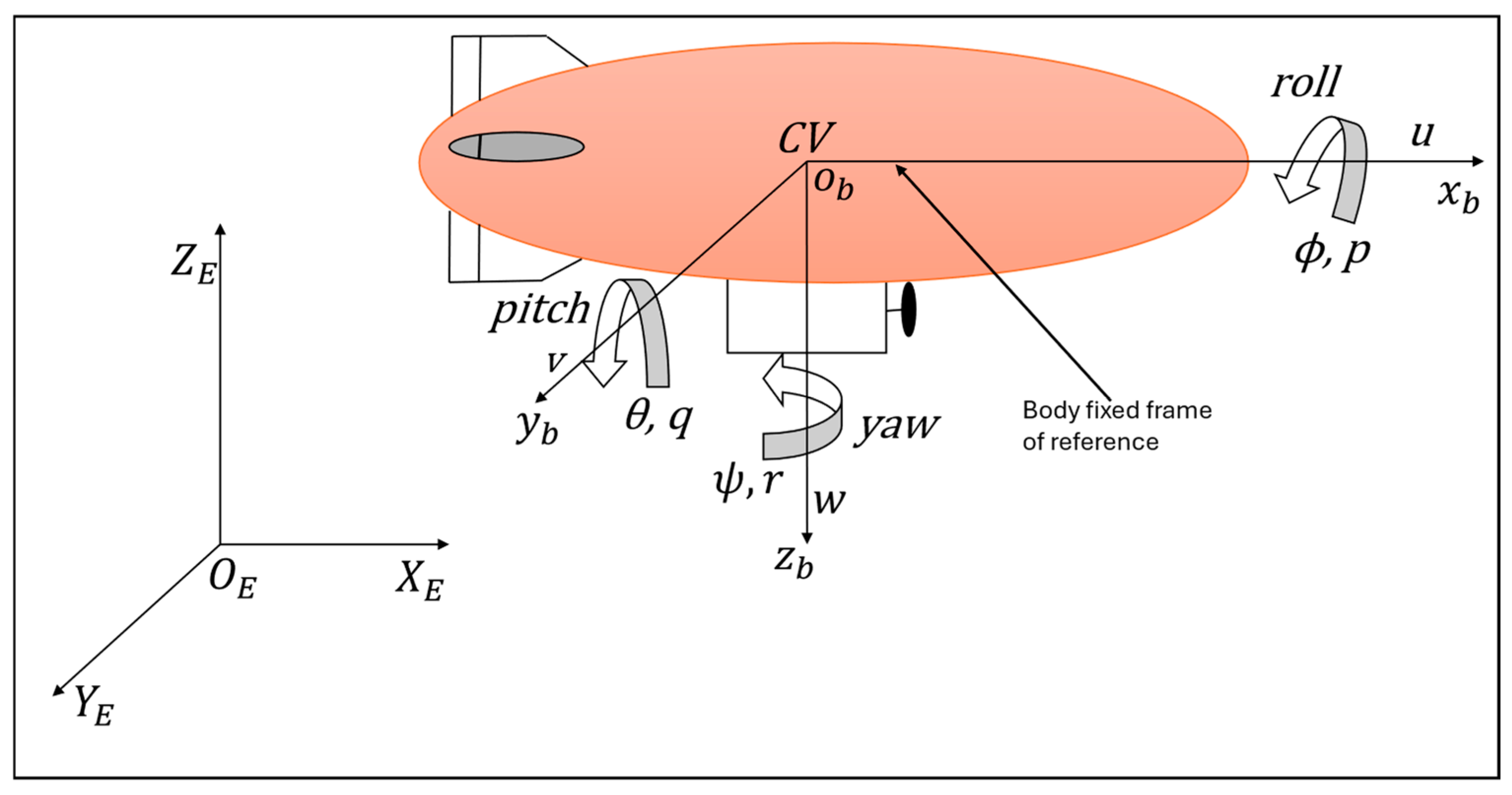
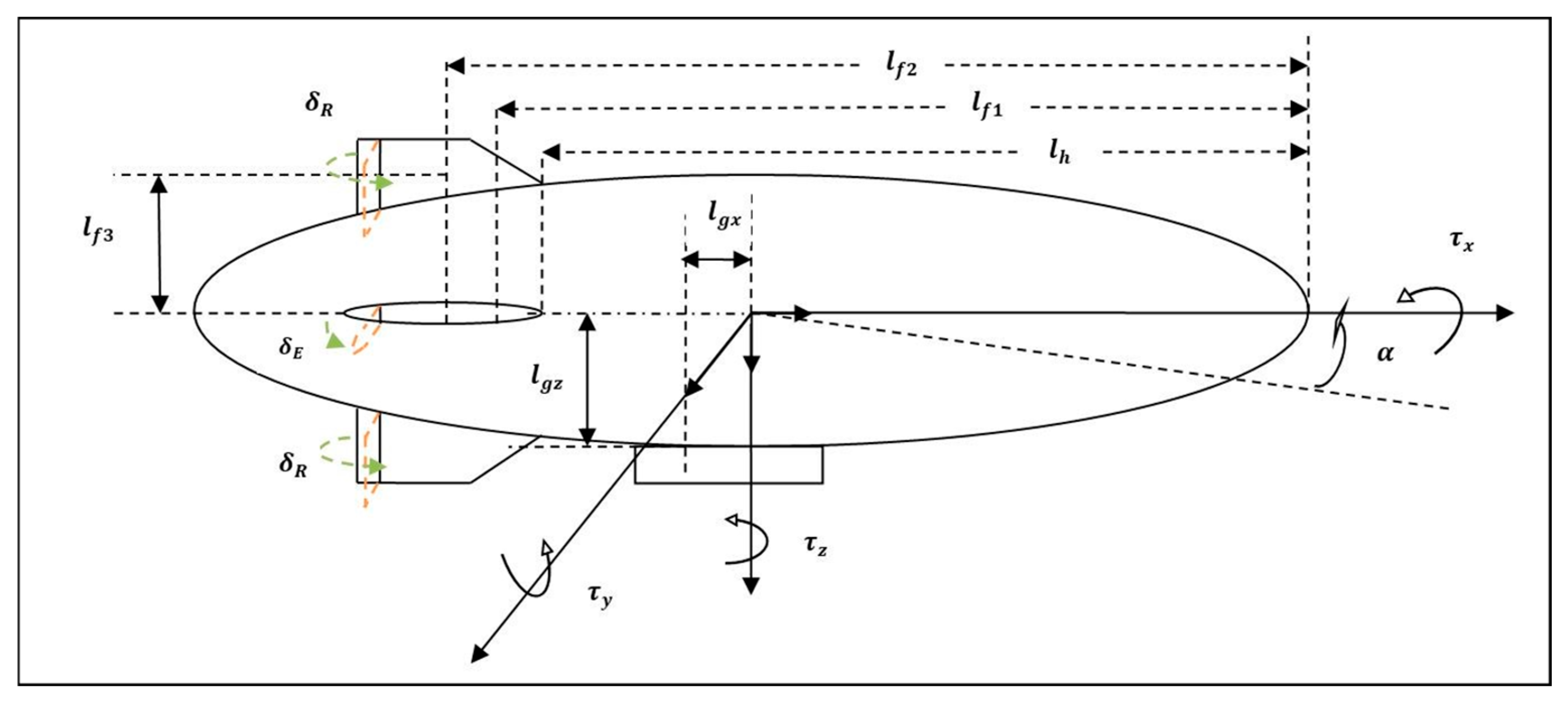
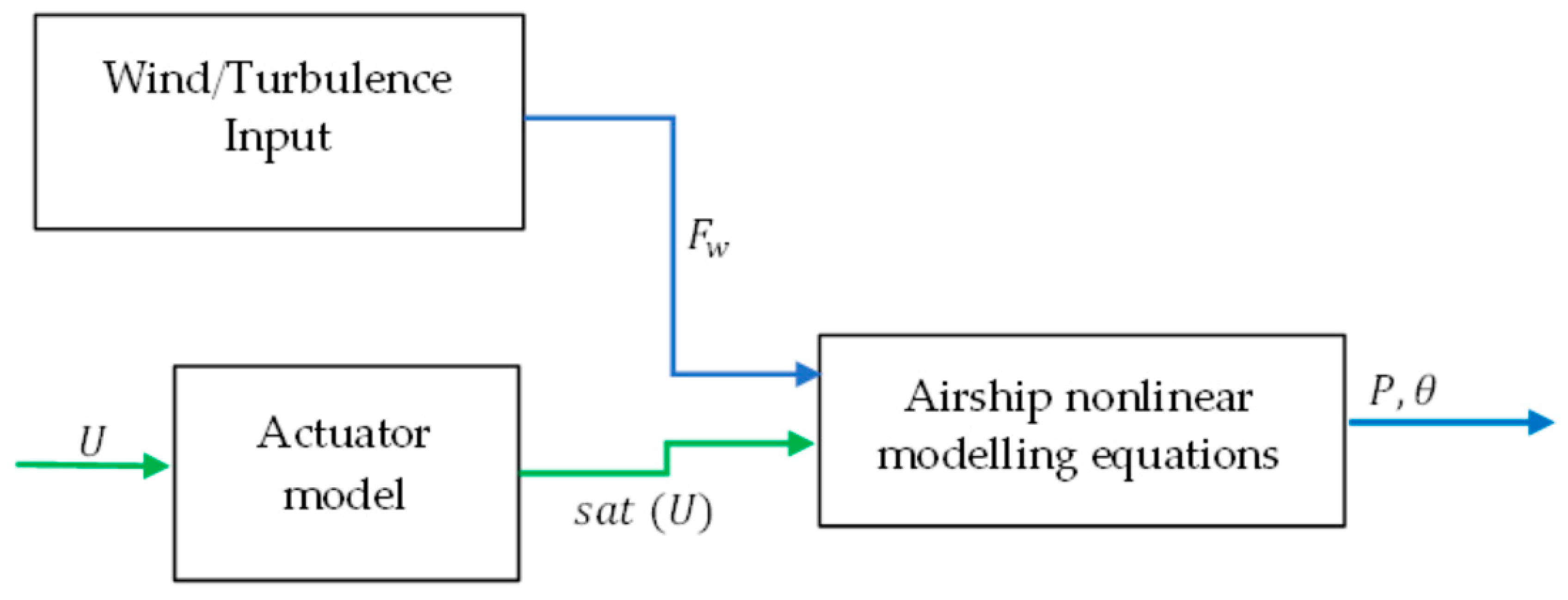
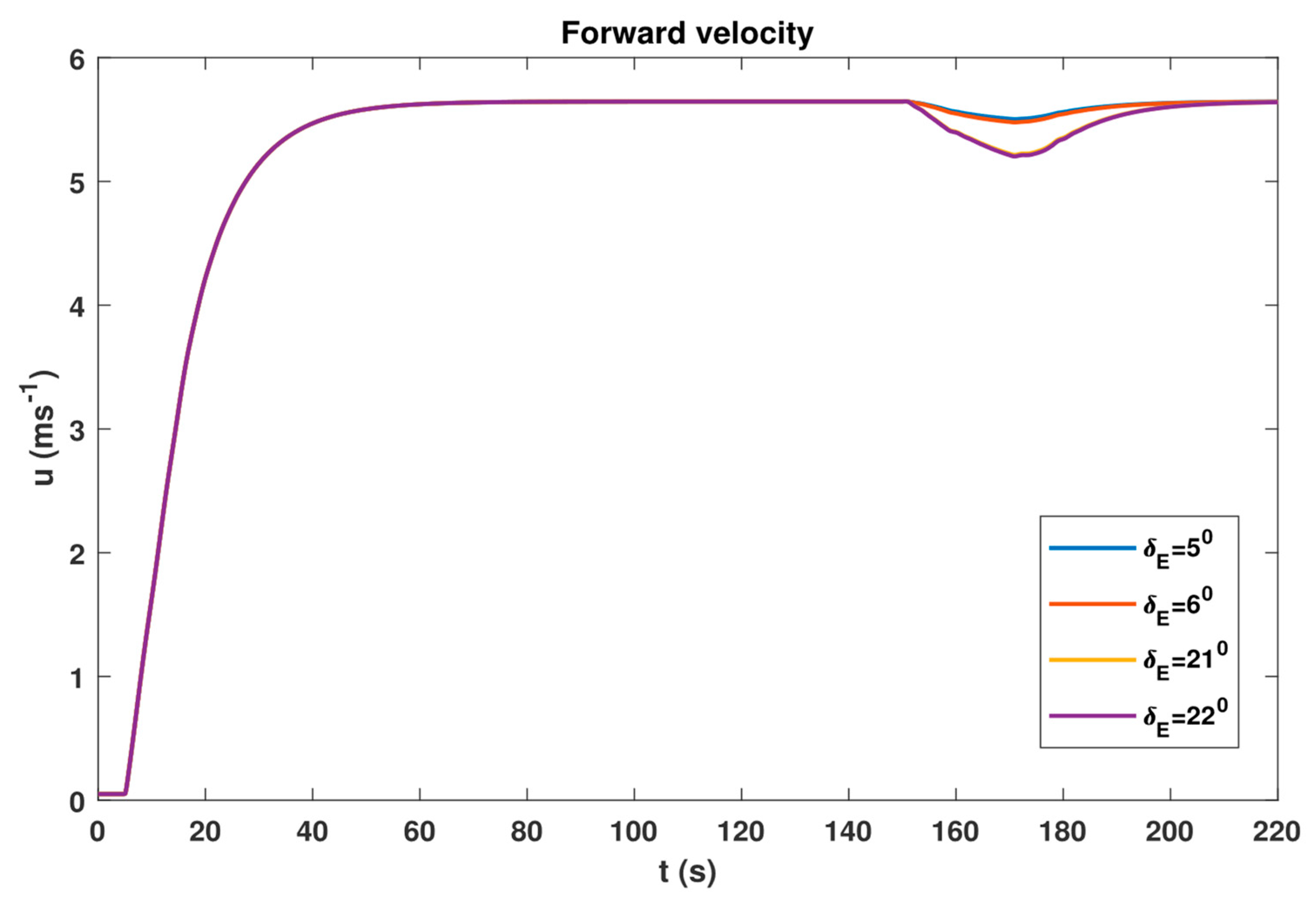
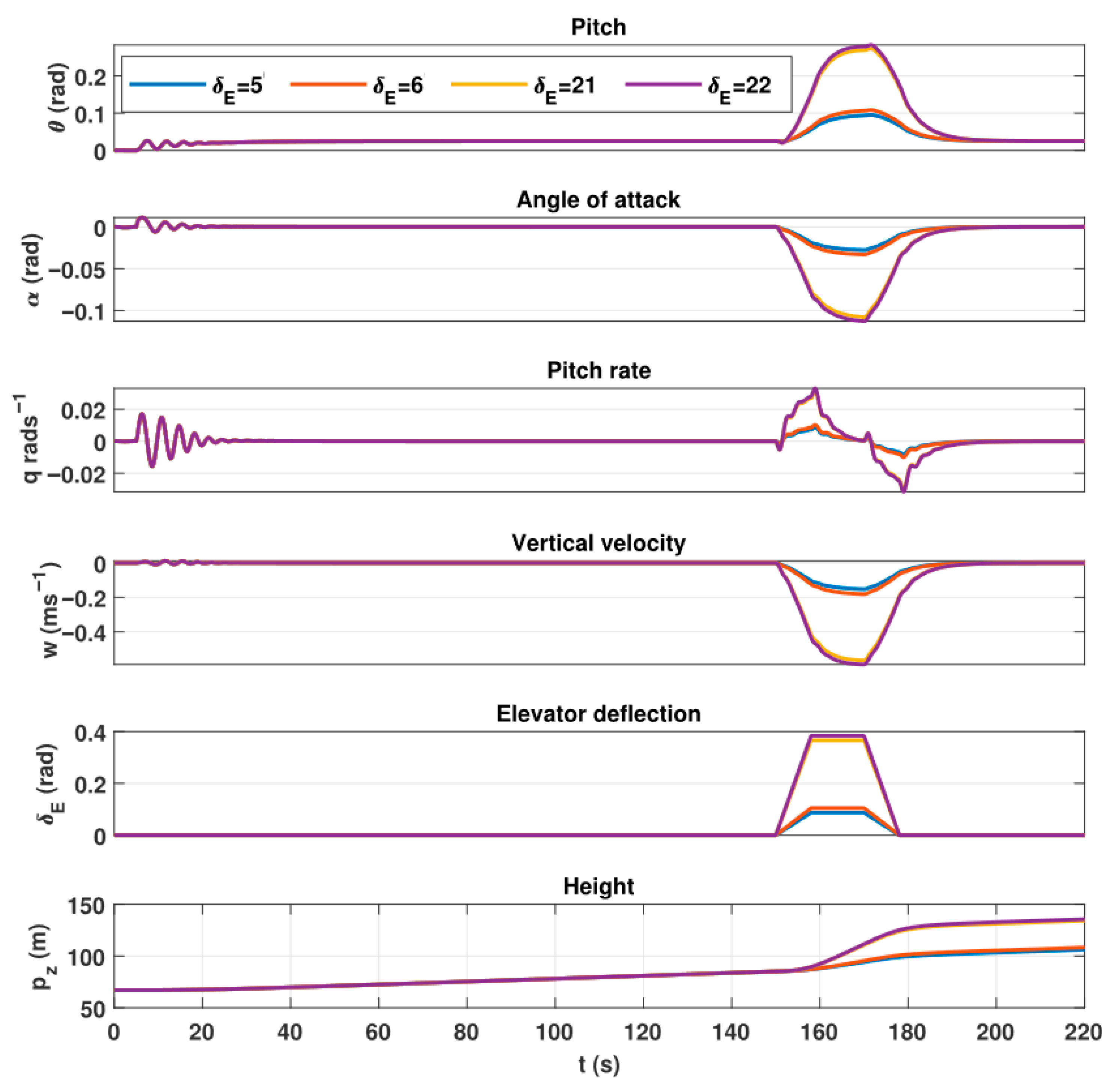


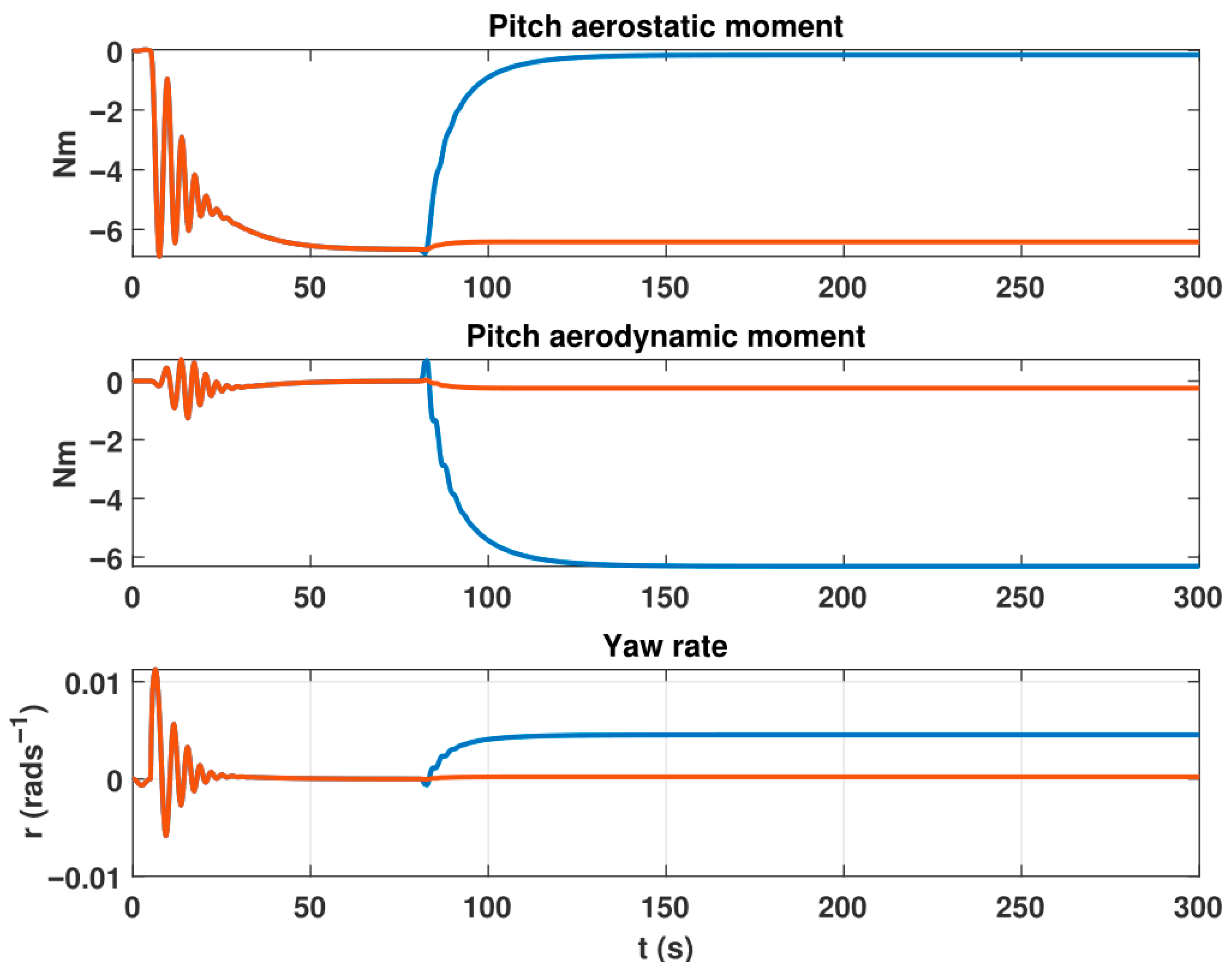
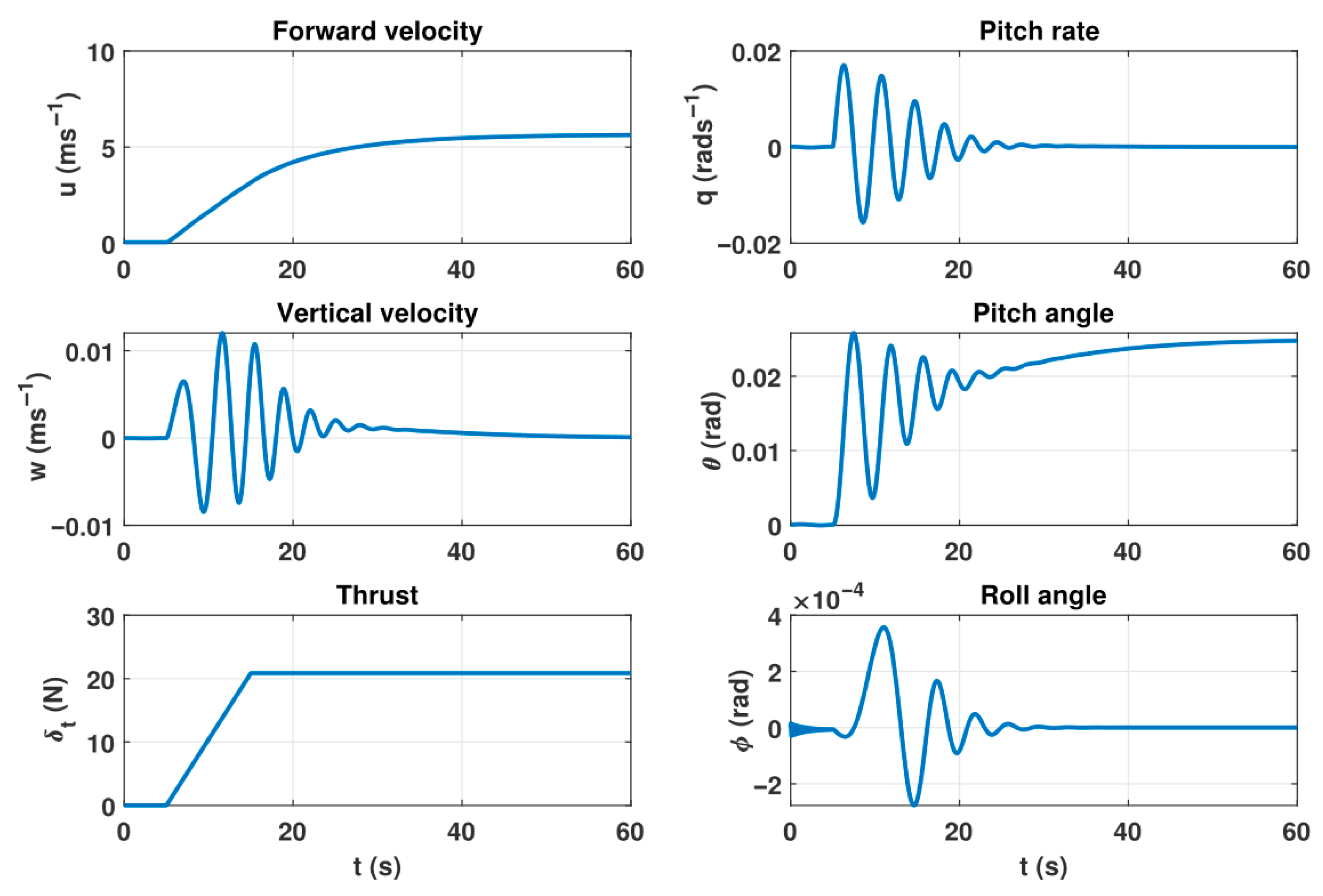
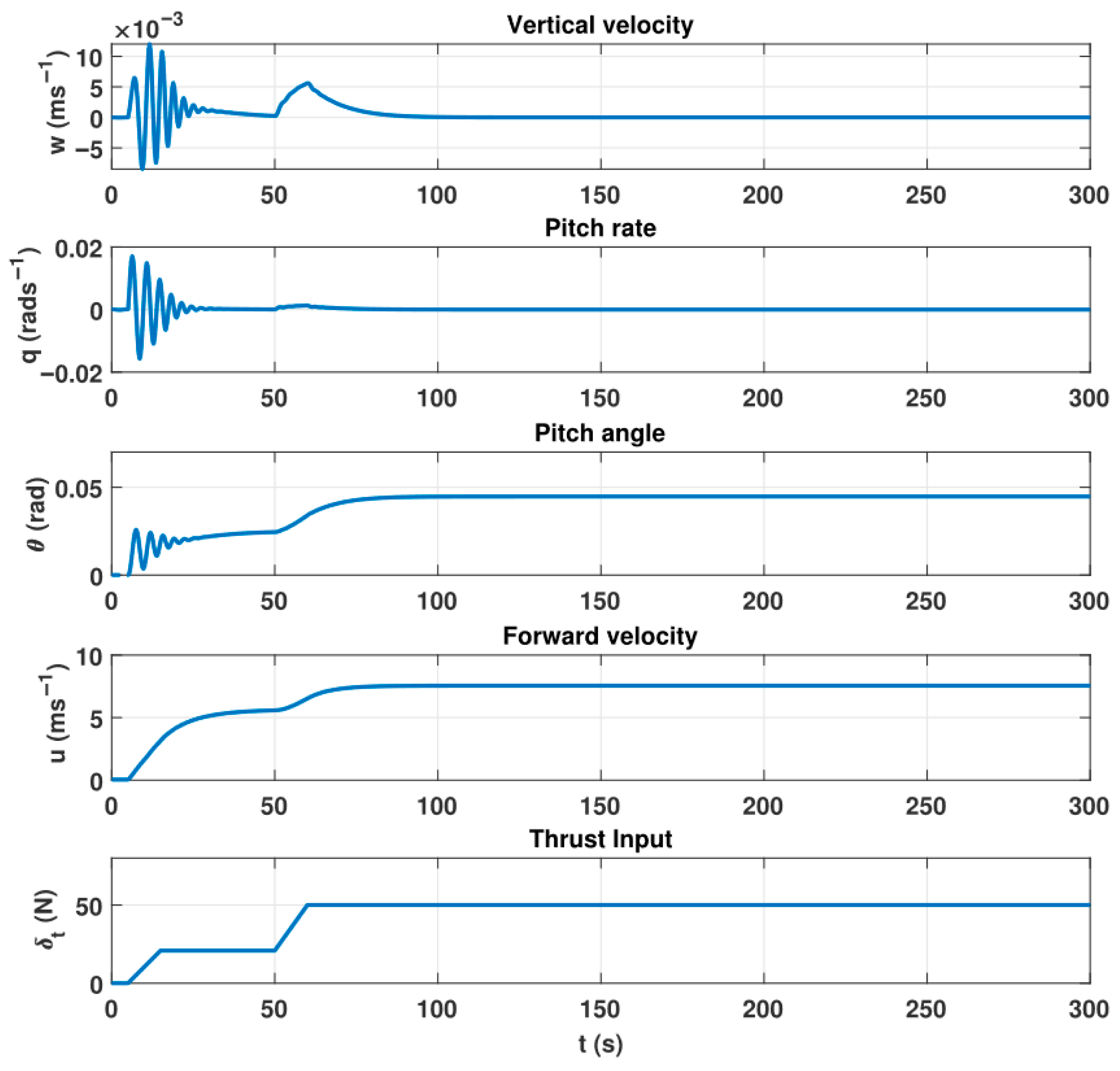
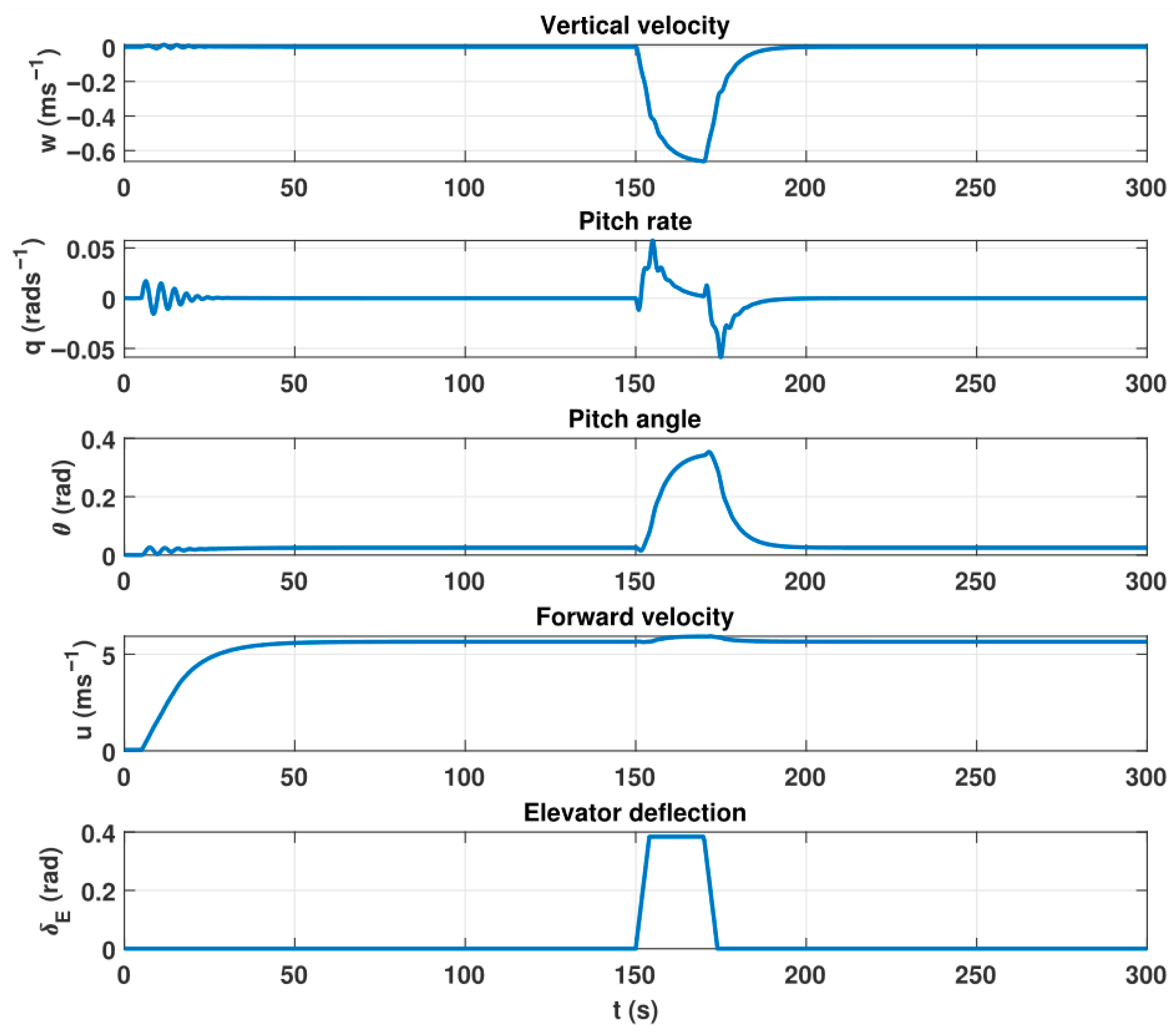
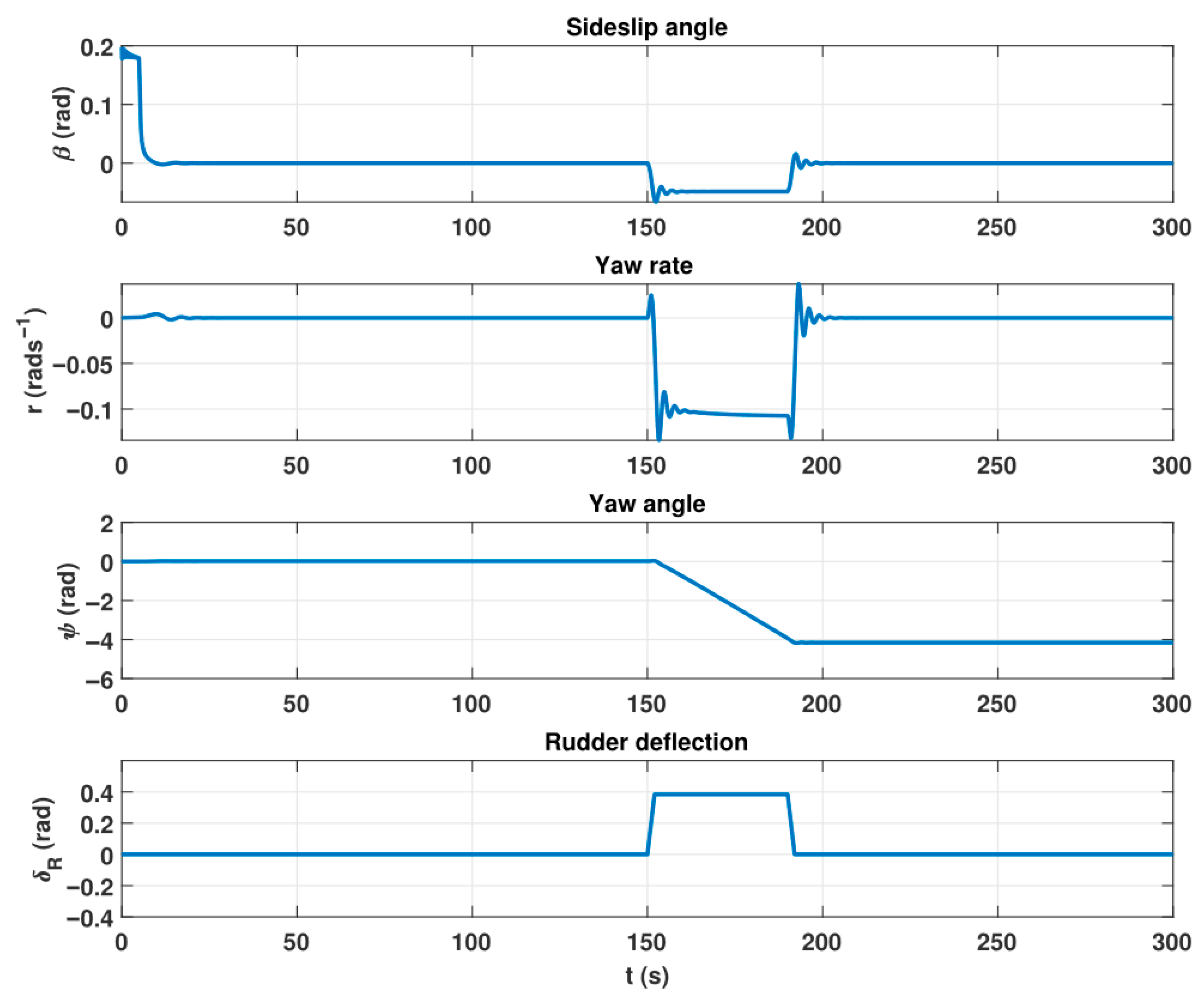
| Parameter | Value | Parameter | Value |
|---|---|---|---|
| 24.073 kg | 11.6513 kgm2 | ||
| 6.443 kg | 176.321 kgm2 | ||
| 48.24 kg | 176.321 kgm2 | ||
| 48.24 kg | 0.1 kgm2 | ||
| 0.33 m | 0.976 m | ||
| 0.33 m | 0 m | ||
| 273.81 N | 273.81 N |
| Parameter | Value | Parameter | Value |
|---|---|---|---|
| −2.37 kg | 0 kgm | ||
| 24.167 kg | 0 kgm | ||
| 0 kgm | 0 kgm | ||
| 0 kgm | 0 kgm | ||
| 0 kgm | 0 kgm | ||
| 0 kgm | 0 kgm | ||
| 0 kgm | 0 kgm |
| Parameter | Value | Parameter | Value |
|---|---|---|---|
| 22.808 m3 | 2.3 m | ||
| 2.2 m | 2.96 m | ||
| 9 m | 1.18 m | ||
| 1.1 m | 0.55 m | ||
| 3.9 m | 8.04 m2 | ||
| 5.1 m | 9 m2 | ||
| 4.43 m | 1 m2 | ||
| 6.43 m | 1.40 m |
| Parameter | Value | Parameter | Value |
|---|---|---|---|
| 0.085 | 5.73 | ||
| 0.865 | 1.24 | ||
| 0.025 | 0.29 | ||
| 0.006 | 1.19 | ||
| 0.01 | 0.3564 | ||
| 0.5 | −0.1758 | ||
| 1.0 | 0.9315 | ||
| 1.0 | −0.1086 |
| Case | Input | Output | Flight Condition | Input Application Time |
|---|---|---|---|---|
| Case 1 | Elevator | Neutral buoyancy, 67 m altitude | 150 s | |
| Case 2 | Rudder | Neutral buoyancy, 67 m altitude | 80 s | |
| Case 3 | Thruster | Neutral buoyancy, 67 m altitude | 5 s |
| Longitudinal | Surge | Heave | Pendulum |
| Linearised simulation model | −0.1012 | −0.2106 | −0.5530 3.1667 |
| Experimental | −0.1797 | −0.3155 | −0.115 0.6458 |
| Lateral | Sideslip subsidence | Yaw subsidence | Roll oscillations |
| Linearised simulation model | −0.3956 2.4145 | −0.7400 4.7032 | |
| Experimental | −0.4934 1.4238 | −0.0844 .0527 | |
| Airship | Length (m) | Maximum Diameter (m) | Mass (Kg) | Fineness Ratio |
|---|---|---|---|---|
| YEZ-2A | 129.9 | 32 | 86816 | 4.047 |
| AURORA | 9 | 3 | 20 | 3 |
| JPL AEROBOT | 11.43 | 2.438 | 42.5 | 4.68 |
| LOTTE | 15 | 4 | 136.8 | 3.75 |
| UETT | 9 | 2.2 | 28 | 4.09 |
| Airship | Surge | Heave | Sideslip Subsidence | Yaw Subsidence |
|---|---|---|---|---|
| YEZ-2A | −0.0056 | −0.0392 | −0.0315 | −0.232 |
| AURORA | −0.1426 | −3.7819 | −0.6080 | −4.9182 |
| JPL AEROBOT | −0.1198 | −0.1971 | −0.6005 | −0.8745 |
| LOTTE | −0.07 | −1.15 | +0.234 | −1.24 |
| UETT simulation | −0.1 | −0.18 | −0.342 1.736 | |
| UETT linearised simulation model | −0.1012 | −0.2106 | −0.3956 .4145 | |
| UETT experimental | −0.1797 | −0.3155 | −0.4934 1.4238 | |
Disclaimer/Publisher’s Note: The statements, opinions and data contained in all publications are solely those of the individual author(s) and contributor(s) and not of MDPI and/or the editor(s). MDPI and/or the editor(s) disclaim responsibility for any injury to people or property resulting from any ideas, methods, instructions or products referred to in the content. |
© 2025 by the authors. Licensee MDPI, Basel, Switzerland. This article is an open access article distributed under the terms and conditions of the Creative Commons Attribution (CC BY) license (https://creativecommons.org/licenses/by/4.0/).
Share and Cite
Wasim, M.; Ali, A.; Sohail, M.U. Development of Nonlinear Six-Degree-of-Freedom Dynamic Modelling and High-Fidelity Flight Simulation of an Autonomous Airship. Processes 2025, 13, 2688. https://doi.org/10.3390/pr13092688
Wasim M, Ali A, Sohail MU. Development of Nonlinear Six-Degree-of-Freedom Dynamic Modelling and High-Fidelity Flight Simulation of an Autonomous Airship. Processes. 2025; 13(9):2688. https://doi.org/10.3390/pr13092688
Chicago/Turabian StyleWasim, Muhammad, Ahsan Ali, and Muhammad Umer Sohail. 2025. "Development of Nonlinear Six-Degree-of-Freedom Dynamic Modelling and High-Fidelity Flight Simulation of an Autonomous Airship" Processes 13, no. 9: 2688. https://doi.org/10.3390/pr13092688
APA StyleWasim, M., Ali, A., & Sohail, M. U. (2025). Development of Nonlinear Six-Degree-of-Freedom Dynamic Modelling and High-Fidelity Flight Simulation of an Autonomous Airship. Processes, 13(9), 2688. https://doi.org/10.3390/pr13092688










